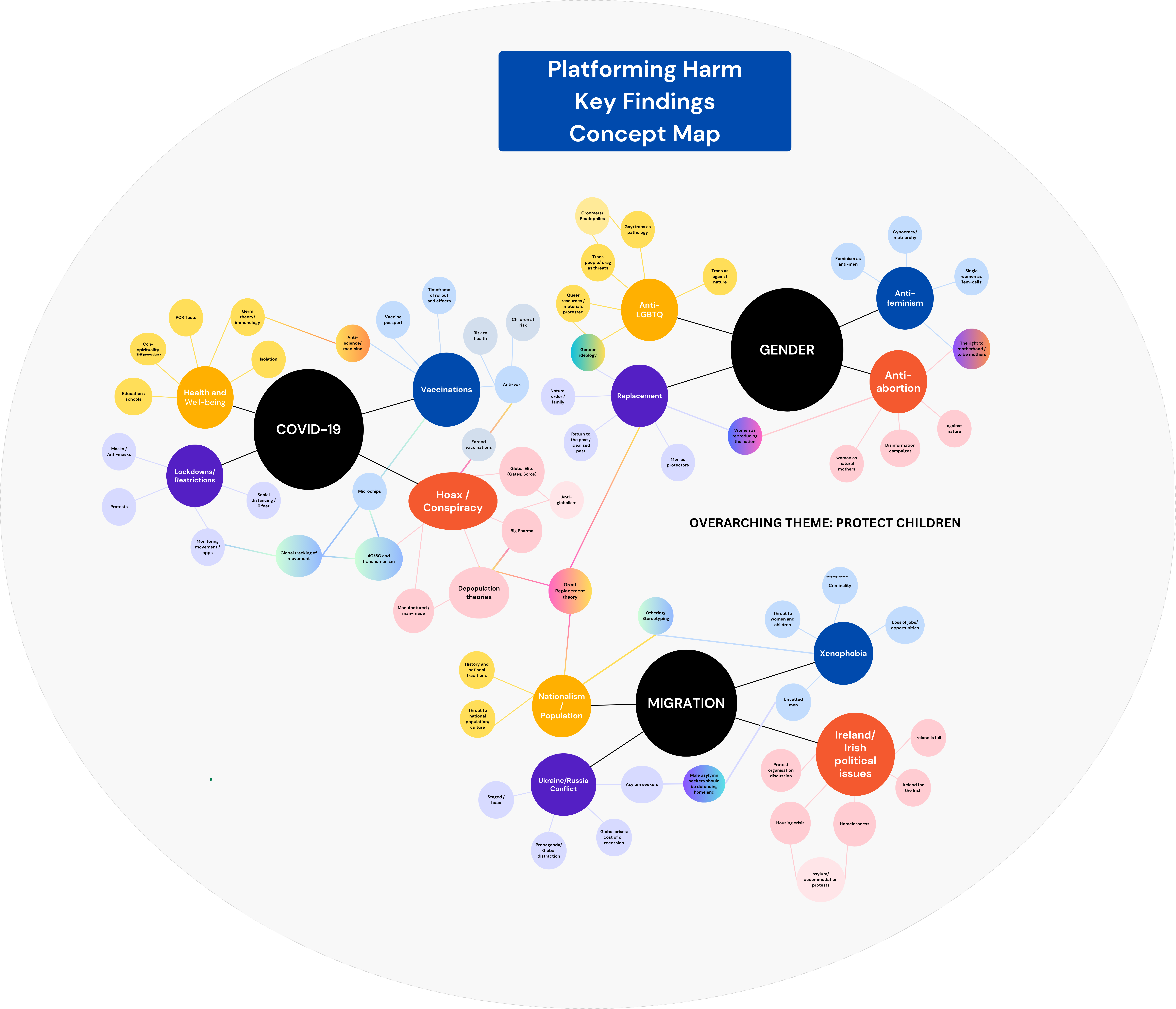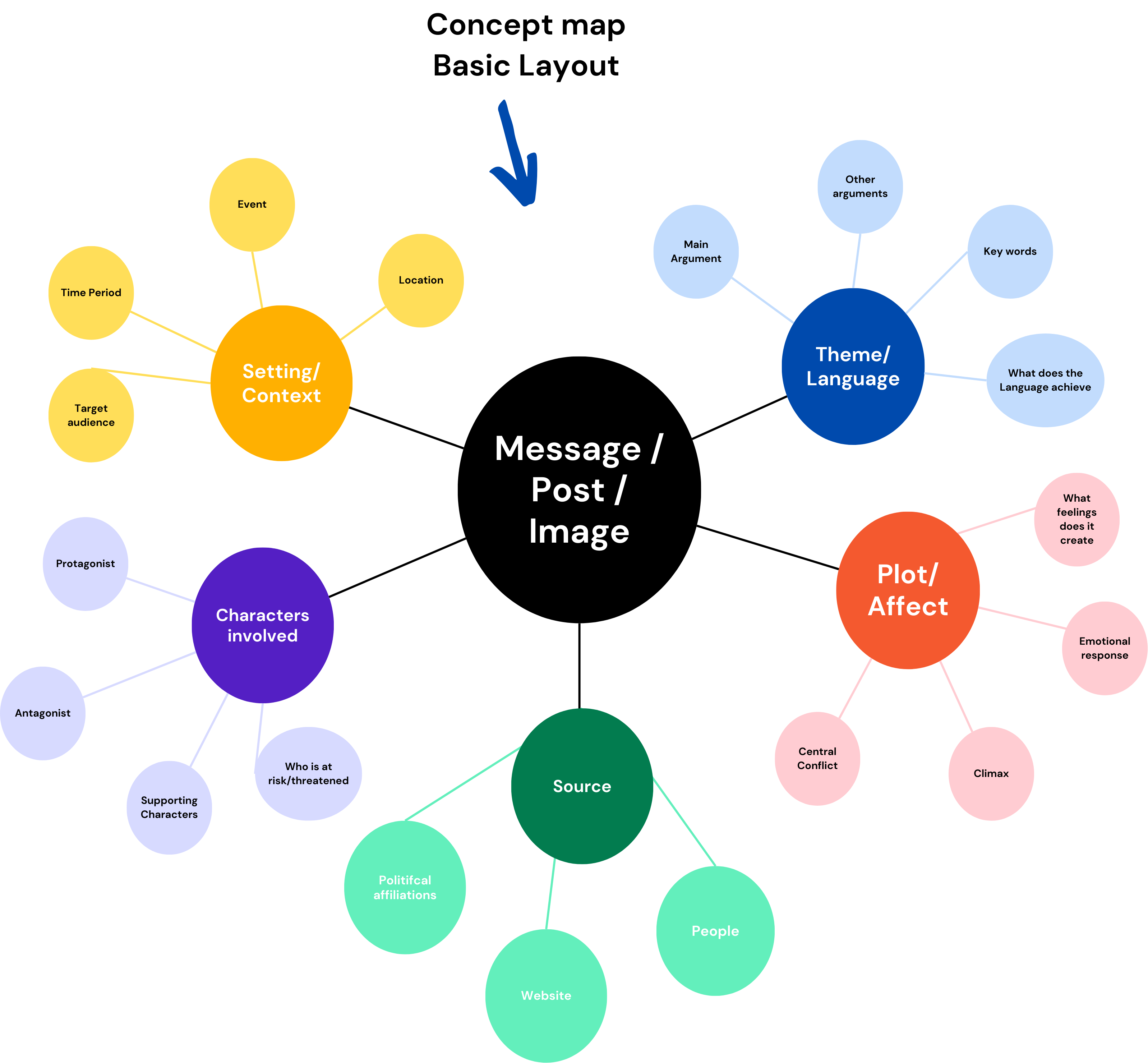Blog Series: Narrative Connections: Using Narrative concept Mapping to Understand the Irish Far-Right
Dr Sarah Anne Dunne and Prof Eugenia Siapera
Narrative Connections: Using Narrative Concept Mapping to Understand the Irish Far-Right
Dr Sarah Anne Dunne and Prof Eugenia Siapera
The IRC-Coalesce funded project, Platforming Harm, began in 2021 with the aim of analysing the circulation of harmful health narratives and disinformation that was emerging on Irish Alt-Tech channels. At the time, Covid-19 had globally affected the everyday lived experiences of millions: ongoing lockdowns, isolating restriction policies and the speedy rollout of the vaccination led to shared experiences of despondency and disaffection that transgressed borders and personal situation (see TMGH-Global COVID-19 Collaborative, 2021; Yang and Lu, 2022). While whether these stressors contributed to the growth of a notable Irish Far-Right movement is contestable, the popularisation of Far-Right narratives that spread on Irish Alt-Tech channels during this time is not. Such Far-Right influences did not limit itself to Covid-scepticism either. In the subsequent years of the study, we noted a substantial growth in the sharing of anti-LGBTQ+ and xenophobic material across these same channels. The discourses emerging largely mirrored global Far-Right political concerns and their methods, often using populist, emotive, and affective language to garner a public response. This led us to the question: what were these narratives attempting to achieve?
Concept Mapping Models
To answer this question, we engaged in a series of research inquiries that utilised digital ethnography, topic modelling and qualitative analysis using data scraped from Irish Alt-Tech channels. Much of our work focused on popular Irish Telegram channel Computing Forever, which provided a promising cross between Far-Right leaning and anti-woke content, alongside social commentary and media critiques. As a starting point for better understanding the narratives spread across these channels, we began conceptualising and capturing primary themes and topics. Ultimately, we located three overreaching frameworks that led many of the more controversial and politically motivated conversations: Covid-19; Gender; Migration [see fig 1]. These frameworks informed much of the discourse emerging on the Irish Alt-Tech channels examined and largely echoed global concerns of the Far-Right. Moreover, as depicted in the diagram, the discourses frequently overlapped and interconnected with one another reflecting the ease with which one can slip into down the radicalisation rabbit-hole.
 Fig. 1: Concept map of linked narratives and key findings.
Fig. 1: Concept map of linked narratives and key findings.
To provide one clear example of these links, we can look to the centre of the concept map and “The Great Replacement Theory” node which connects all three frameworks. This theory, largely popularised by Renaud Camus’ book Le Grand Remplacement, maintains that the white race and white culture is under threat of extinction and that white people are being “replaced” owing to mass migration. Such conspiracy theories point to the perceived exceptionalism and supremacy of whiteness and, in Camus’ estimation, Europeanness also (Bossen). This ideology, repeated by many conservative and right-leaning pundits, espouses obvious anti-migration themes, othering migrants as threats to white supremacy and amplifying xenophobic fears. Within the Irish channels analysed, these narratives manifested as fears that Irish culture and a distinctly Irish beingness was jeopardised owing to the migration of Ukrainian and Middle Eastern refugees with fears specifically being stirred around the movement of “unvetted males” into the country: such narratives implicitly suggesting criminal and sexual threat, reiterating the tired trope of the Black/Brown rapist (Chouhya and Madero-Hernandez, 2019).
How this discourse links to the Covid-19 framework is, unsurprisingly, via its reliance on conspiratorial thinking: the very Covid-sceptic frameworks which positioned the pandemic as a hoax orchestrated by a sect of global elites comfortably sits aside conversations on population control, eugenics and anti-vaccination discourses on these channels. Covid-19, an exceptional time and space, provided ample opportunity for the growth of conspiracies (Richards, 2022, pg. 110). The emotive attributes of many conspiracy theories, especially in terms of managing people’s anxieties and uncertainties, is well known (Douglas, 2021) and speaks to the volume of conspiracy to emerge in connection with the pandemic, with the great replacement discourse further amplifying fears that accentuate Far-Right political discourse.
This conspiracy has become further repurposed into conversations around gender and concerns with “gender ideology.” The concept of “gender ideology” has become central within conservative and Far-Right politics in undermining LGBTQ+ rights and freedoms. Rather, gender now being framed as indoctrinating children into perverse and deviant sexualities, undoing traditional patriarchal structures such as the family and advocating the ever-feared “gay agenda.” In many ways, it has become a catch-all within the Far-Right movement. Indeed, Judith Butler has noted in her most recent work that gender is now “identified as a threat to all life, civilization, society, thought, and the like […] to gather up a wide range of fears and anxieties – no matter how they contradict one another – package them into a single bundle an subsume them under a single name” (2024 pg. 5). LGBTQ+ people and, in recent discourse, particularly trans people, are understood as predators within this framework with children positioned as those most at risk (Stone, 2019). Within this discourse, gender becomes “a monolith, frightening in its power and reach” (2024).
The connections across these frameworks, as stated, depict the ease with which radicalisation takes place online as discourses move seamlessly together, building more robust Far-Right ideologies that centralise certain narratives. It was the role of these narratives that we ultimately came to question. In analysing these messages and building the concept map [fig. 1] the role of narratives in evoking emotional responses and building convincing concepts became evident: each message shared on these channels shared a particular worldview, many working towards convincing and radicalising reader’s into a Far-Right mindset. This awareness provided us with a conceptual framework [see fig. 2] for breaking down Far-Right narratives in the hopes of understanding their roles and aims and for building our intervention into digital media literacy more broadly.
Digital Media Literacy and Narrative Frames
The Platforming Harm Project was developed particularly with digital media literacy in mind. In fact, Media Literacy Ireland offered their expertise as advisors on our suggested interventions; and we have also developed a syllabus that reflects our key findings alongside noted media literacy toolkits. Like many media literacy practitioners and scholars of social media studies, we queried how best to intervene in the spread and belief in disinformation narratives. Ultimately, we found that heuristic practices such as researching sources and assigning credibility to authors were easily manipulated to challenge people’s worldviews and could be misconstrued based on an individual’s belief systems also. Andrew Tate, for example, enjoyed enormous success and popularity across social media platforms despite the harmful and disinformative narratives he shared and in spite of well-known critiques of his ideas. In this regard, researching the source and their credibility was often overlooked or deemed unimportant to many, as his message had value regardless.
It seemed essential, for us, to move beyond this heuristic approach and to build broader understandings of the narratives being circulated and their aims. Thus we developed our conceptual methodological framework [see fig. 2]: a variable graph that looks for key information about the narrative in order to fully deconstruct and comprehend its goals. Topics include the well known creed of checking the source and considering credibility but also extend to incorporate the plot, the different characters and affiliations, the language used and perhaps most significantly, the emotion/affect the message aims to induce in the reader. The use of narrative mapping we suggest is only a basic one; indeed, we found mapping a more promising methodology for examining disinformation and harmful narratives owing to its versatility and variability. The fact that nodes can be added or removed based on the message is significant. The mapping, furthermore, incorporates a broader use of empathy in its engagement, encouraging the development of holistic worldviews and to consider the social issues often implicated within Far-Right discourse.

Fig. 2: Concept map layout
Though we have yet to fully utilise this narrative concept mapping, we are optimistic that it provides a new intervention into assessing disinformation and harmful narratives that can be used across the board. Indeed, while the media literacy syllabus mentioned here is primarily geared at third level students and would engage students in this concept mapping, its possible uses by civil society organisations, in government sectors and among groups educating citizens on digital literacy and digital citizenship more broadly may benefit from such a model. It is our hope that we can employ this model in future student courses and modules, and we invite others to do so too.
For a more detailed view of the concept maps and examples, use the following link.
References
- Bossen, C. (2024). Political theology, discovery and the roots of the ‘great replacement’. Race & Class, 0(0). https://doi.org/10.1177/03063968241238601
- Butler, Judith. Who’s Afraid of Gender?. Knopf Canada, 2024.
- Chouhy, C., & Madero-Hernandez, A. (2019). “Murderers, Rapists, and Bad Hombres”: Deconstructing the Immigration-Crime Myths. Victims & Offenders, 14(8), 1010–1039. https://doi.org/10.1080/15564886.2019.1671283
- Douglas, K. M. (2021). COVID-19 conspiracy theories. Group Processes & Intergroup Relations, 24(2), 270-275. https://doi.org/10.1177/1368430220982068
- Richards, Imogen. “Neoliberalism, COVID-19 and conspiracy: pandemic management strategies and the far-right social turn.” Justice, Power and Resistance 5.1-2 (2022): 109-126.
- Stone, Amy L. “Frame variation in child protectionist claims: Constructions of gay men and transgender women as strangers.” Social Forces 97.3 (2019): 1155-1176.
- TMGH-Global COVID-19 Collaborative. Perceived Stress of Quarantine and Isolation During COVID-19 Pandemic: A Global Survey. Front Psychiatry. 2021 May 25;12:656664. doi: 10.3389/fpsyt.2021.656664
- Yang, P., Lu, Y. (2022). Navigating Desire, Despondency, Disconnectedness, and Disillusionment: International Students’ Emotional Turmoil Amidst COVID-19 Pandemic. In: Cheng, Y. (eds) International Student Mobilities and Voices in the Asia-Pacific. Palgrave Macmillan, Singapore. https://doi.org/10.1007/978-981-19-3675-3_9
This work is supported by the Irish Research Council, grant number COALESCE 2021/39